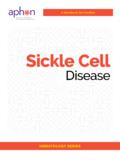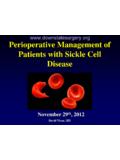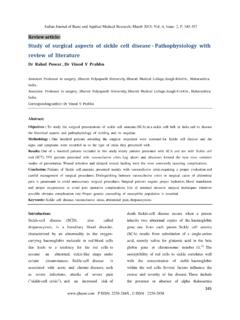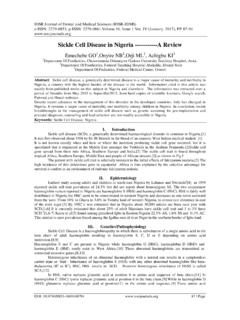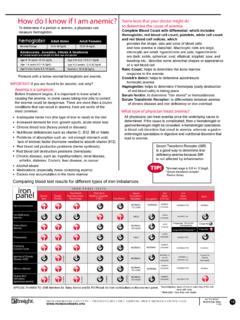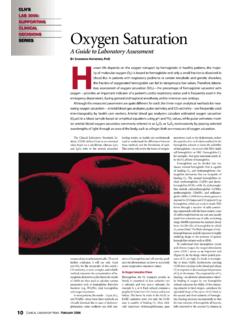Transcription of Pharmacotherapy of Sickle Cell Disease - WHO
1 18th Expert Committee on the Selection and Use of Essential Medicines (21 to 25 March 2011) NEW SECTION (Adults and Children) Pharmacotherapy of Sickle Cell Disease Kathleen A. Neville, , , and Julie A. Panepinto, , 1 Associate Professor of Pediatrics University of Missouri Kansas City Director, Experimental Therapeutics in Pediatric Cancer Program Divisions of Pediatric Clinical Pharmacology and Medical Toxicology and Hematology/Oncology, Children s Mercy Hospitals and Clinics 2 Associate Professor of Pediatrics, Hematology Department of Pediatrics, Section of Hematology/Oncology/Bone Marrow Transplantation Medical College of Wisconsin/The Children's Research Institute of the Children's Hospital of Wisconsin, Milwaukee, WI 1 Summary.
2 Sickle cell Disease (SCD) is a potentially devastating condition that is caused by an autosomal recessive inherited hemoglobinopathy which results in the vaso-occlusive phenomena and hemolysis. The severity of the complications that occur with this disorder are widely variable, but overall mortality is increased and life expectancy decreased when compared to the general population. Care of patients with Sickle cell Disease is largely supportive with hydroxyurea representing the only widely used drug which modifies Disease pathogenesis. Painful vaso-occlusive events are the most common complication experienced by both children and adults with Sickle cell Disease and there are few treatment options to prevent the development of these events.
3 Most are managed with traditional supportive care measures ( aggressive hydration, anti-inflammatory and narcotic analgesics) that have not changed in decades and which are adequately met by the current World Health Organization (WHO) Essential Medicines List (Table 1). Table 1. Pharmacotherapeutic agents utilized in the treatment of Sickle cell Disease which are currently on the Essential Medicines List and the Clinical Use of Blood Handbook. Disease Modifying Agents hydroxycarbamide (hydroxyurea)* Supportive Care Agents Analgesics paracetamol ibuprofen codeine morphine Antibiotics phenoxymethylpenicillin cefotaxime Pertinent Vaccines pneumococcal vaccine Systemic Treatments Parenteral 5% glucose, sodium chloride Red blood cell transfusion ( ) Iron Chelators Deferoxamine *On list for treatment of cancer not Sickle cell Disease .
4 Also not on essential medicines list for children 2 Sickle Cell Disease : Background Etiology and Epidemiology Sickle cell Disease (SCD) is a potentially devastating condition that is caused by an autosomal recessive inherited hemoglobinopathy, which results in the hallmark clinical sequelae of vaso-occlusive phenomena and hemolysis. The genetic abnormality is due to a substitution of the amino acid valine for glutamic acid at the sixth position on the beta globin chain and was first described over one hundred years Hemoglobin S (HbS), the hemoglobin that is produced as a result of this defect, is a hemoglobin tetramer (alpha2/beta S2)
5 That is poorly soluble and polymerizes when Overall, the incidence of Sickle cell Disease exceeds that of most other serious genetic disorders, including cystic fibrosis and It is seen worldwide but occurs most frequently in Africans and less commonly in those of Mediterranean, Latino, East Indian, and Arab It is estimated that 16% of the population in Africa has a Sickle hemoglobinopathy which is the highest proportion worldwide. The Americas and the East Mediterranean region represent the next highest proportion of Sickle cell hemoglobinopathy as delineated by the World Health SCD results from any combination of the Sickle cell gene with any other abnormal -globin gene and there are many types of SCD.
6 The most common types include Sickle cell anemia (Hb SS), the Sickle beta-thalassemias (Hb S 0 and Hb S +), hemoglobin SC Disease (Hb SC) and Sickle cell Disease with hereditary persistence of fetal hemoglobin (S/HPFH). HbSS is the most common form of Sickle cell Disease . Patients with Hb SS and Hb S 0, in general, have the most severe forms of SCD including lower hemoglobin levels and more frequent vaso-occlusive and hemolytic complications. Sickle -C (Hb SC) Disease is the second most common form of SCD. Patients with this type of SCD generally have a more benign clinical course than do patients with Hb SS or Sickle 0-thalassemia.
7 Likewise, patients with Sickle +-thalassemia and S/HPFH also generally have a more benign clinical course and patients with S/HPFH may actually have hemoglobin levels that are or approach normal. Adults with Sickle cell Disease who live in the United States have a decreased life expectancy with the odds of surviving beyond the 7th decade of life reported to be less than 30%.7 Historically, Platt et al. reported a large number of adults with Sickle cell Disease who died during acute Sickle cell related complications such as pain, acute chest syndrome, and In this era, the most common causes of death in adults from Sickle cell Disease reported are pulmonary hypertension, sudden death of unknown etiology, renal failure, and With regard to children with SCD, in the developed world, the mortality rate is estimated to be as low as per 100,000 children.
8 This is in contrast to higher rates in developing countries such as the Republic of Benin which recently reported a mortality rate of per 1,000 children (or 1,550 per 100,000 children).9 The most common causes of death in childhood from Sickle cell Disease are infection, acute chest syndrome and Pathophysiology There is a large amount of heterogeneity in the expression of Sickle cell Disease which is not fully explained by the single mutation or different variants of hemoglobin S. This variability is manifest by a wide spectrum in both frequency and intensity of painful vaso-occlusive crises as well as highly variable degrees of organ dysfunction.
9 The pathophysiologic processes that lead to Sickle cell Disease related complications result from a combination of hemolysis and vaso-occlusion. Hemolysis occurs as a result of repeated episodes of hemoglobin polymerization/depolymerization as Sickle red blood cells pick up and release oxygen in the circulation. Red blood cell membranes become abnormal from this process and red blood cells have a shortened lifespan. Hemolysis can occur both chronically and during 3acute painful vaso-occlusive crises and also results in the release of substantial quantities of free hemoglobin into the vasculature.
10 This resultant free ferrous hemoglobin likely consumes significant quantities of nitric oxide (NO),12 which in turn, leads to abnormal regulation in vascular In addition to hemolysis, intermittent episodes of vascular occlusion cause tissue ischemia, a major morbid component of the disorder which results in acute and chronic multi-organ dysfunction,15 and which is characterized by chronic inflammation and ischemia-reperfusion Data suggest that neutrophils play a key role in the tissue damage which occurs as both neutrophil numbers are increased and evidence suggests that they are abnormally activated and Likewise.










